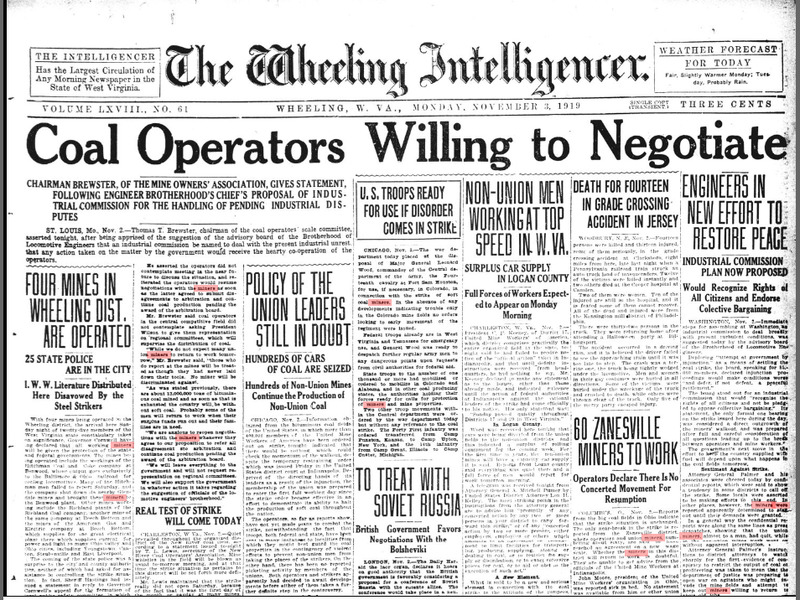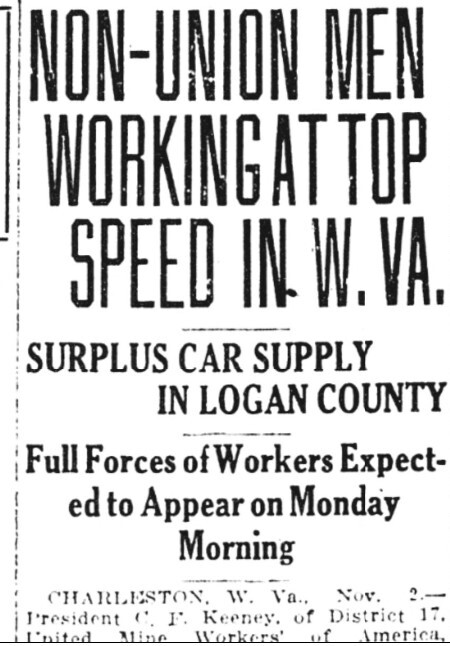Political and Economic Situation
This newspaper, The Intelligencer, Wheeling, WV. Details strikes that occurred during 1919, where efforts were made from the UMW to organize a nation-wide strike. The main heading is the coal operators are willing to negotiate in parts of the country. Chairman Brewster, of the Mine Owner’s Association, asserted that an industrial commission be named to deal with industrial unrest. There is a subheading that directly addresses how non-union men are working at top speed in W.V. This is a major issue that fueled the anger and frustrated the efforts to organize labor in WV which ultimately led to Battle of Blair Mountain. The non-union coal fields in the state that were destabilizing the collective efforts made by UMW to bargain. This was driving a wedge further between the coal miners and operators. However, throughout the paper other states are known to have non-union coal fields, but mostly the states were overwhelmingly supported by organized labor. Furthermore, the efforts of the strikers were effective where there was union labor in states such as: West Virginia, Pennsylvania, Ohio, Indiana, and Illinois. Non-union fields were operating at full capacity with a surplus of railcars as the cars were being diverted from union fields to non-union fields.
This newspaper, The West Virginian, of Fairmont, W.V., main title describes a standoff between 500 miners and the authorities of Brooke County. The Sheriff H.H. Duvall and eleven miners were killed in the gunfight near Cliftonville. The date is July 17, 1922.

Coal Operators Willing to Negotiate, Front Page of The Wheeling Intelligencer 11.3.1919
The Wheeling intelligencer. [volume] (Wheeling, W. Va.), 03 Nov. 1919. Chronicling America: Historic American Newspapers. Lib. of Congress. <https://chroniclingamerica.loc.gov/lccn/sn86092536/1919-11-03/ed-1/seq-1/
The newspaper documents coal strikes and confrontations that plagued America—specifically the tri-state area: West Virginia, Ohio, and Pennsylvania. Newspapers detailing standoffs, strikes, gunfights, and walkouts were an ordinary read. The areas affected are Appalachia and the surrounding geography of the tri-state area is noted above. The President of the United States was deliberating on taking immediate action to send in federal troops and overtake the mines on strike and provide protection to the operators. The coal operators were seemingly reluctant to hand everything over to the federal government and undecided on what to do; It appears they were being constrained by the collective efforts of labor disputes but didn’t want to add to the intensity of the disparities. Other trades and industries are having similar strikes around the time-frame centered around Battle of Blair Mountain. Other articles discuss the B&O Trains are still running late as a consequence of strikes. A subheading discusses the shopmen’s strike had led to the shortage of railcars and tardiness to transport coal.

Sheriff and 11 Others are Killed in Fight at Mine Near Wellsburg, The West Virginian Front Page 7.17.1922
The West Virginian. [volume] (Fairmont, W. Va.), 17 July 1922. Chronicling America: Historic American Newspapers. Lib. of Congress. <https://chroniclingamerica.loc.gov/lccn/sn86072054/1922-07-17/ed-1/seq-1/>
Evidenced above it is reasonable to see labor organization and coal operators continued efforts to combat each other by striking and use of violence. There wouldn’t be any legislation to help settle these disputes until the next decade.
The violence was ubiquitous; The events at Paint-Creek and Cabin-Creek and The Matewan Massacre, tensions reached a climax as the Battle of Blair Mountain required intervention from the federal government. Since the battle was considered the largest uprising on American soil since the Civil war. One could imagine the federal government having no choice but to intervene.
As noted above, there wasn’t any legislation that was pro-unionization. The efforts to organize, support, and provide activism fell on individuals who were close to the fighting. This project will highlight one key figure that inspired miners.
